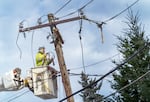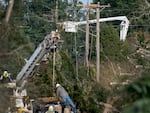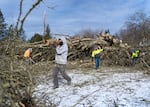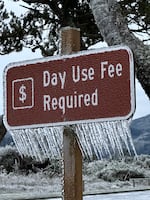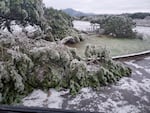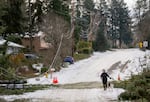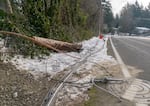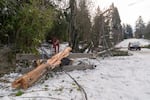
Icicles hang on a vehicle on Wednesday, Jan. 17, 2024, in Tigard, Ore.
Jenny Kane / AP
Freezing rain is expected in much of Northwest Oregon Tuesday afternoon, which likely means more power outages and falling trees. The region already has experienced many downed trees and power lines since stormy conditions picked up Friday.
An ice storm is forecast for much of the Willamette Valley Tuesday afternoon into Wednesday morning. Weather forecasters expect the most intense showers between 5 p.m. and 10 p.m. Tuesday, with residual rain throughout the night. National Weather Service meteorologist Rebecca Muessle says strong winds could cause even more trees to topple over. “So especially those that might already be a little bit loose from the wind and damaged ones that are already close to those power lines. The freezing rain will add that weight and encourage those trees to fall,” Muessle told OPB.
Related: Portland Public Schools, other districts, cancel Wednesday classes
But temperatures are expected to increase rapidly starting Wednesday morning, hitting as much as 30 degrees warmer in some areas. Even so, Muessle says ice melts slower than snow, so the agency is not concerned about floods or landslides.
Here’s what Oregonians should know as the ice storm approaches Tuesday.
Attempts to stay warm
With at least eight deaths linked to cold temperatures or falling trees across the state, people living outside and those who have lost power in the storm have flocked to warming shelters across Northwest Oregon in record numbers since Friday.
Twelve warming shelters were open across Portland and Gresham on Tuesday afternoon, operated by Multnomah County, the state and several nonprofit organizations. It’s the largest number of shelters the county has ever opened during a weather emergency. In all, the 12 shelters served a record 1,181 guests overnight Monday. Multnomah County’s shelters were expected to remain open until at least 8 a.m. Wednesday.
Related: Deaths linked to freezing rain, cold winds in Oregon
Washington County opened its third warming shelter Monday night after seeing a surge in demand. As of Tuesday morning, the shelters were serving around 140 people. Washington County planned to keep shelters open until at least midday Wednesday.
Clackamas County has served more than 200 people per night at two emergency shelter sites throughout the storm. These shelters will stay open until at least Thursday morning, according to a county spokesperson.
Shelters in Clackamas and Washington counties have seen more visitors than in previous weather emergencies, but found they had enough volunteers and staff to meet the heightened need. But the unprecedented demand left Multnomah County shelter staff spread thin. Since Monday, the county has urged commuity members to sign up for volunteer shifts if they’re able to safely travel to a warming shelter.
When is the freezing rain going to arrive? Variability is high because warm fronts tend to move a bit slower. The southern Willamette Valley could start to see freezing rain as early as 12 PM. Rain will shift northward through the evening.
— NWS Portland (@NWSPortland) January 16, 2024
Find your local timing on our website. pic.twitter.com/7TMtLbULew
Phil Barber spent the past several nights volunteering at a warming shelter in North Portland’s Charles Jordan Community Center. Barber said he was initially the only person signed up to support Monday’s overnight shift. After a call for volunteers by the county, a dozen other people joined him.
Barber, who has volunteered at Portland warming shelters for years, spent his shifts serving hot cocoa, coffee, and food to visitors. He met guests who were experiencing homelessness, people whose homes were without power, and others who said they just needed a place to warm up.
“These shelters really play host to an incredibly wide variety of folks in our community who are united by a specific weather event that is making life dangerous,” he said.
Barber said he was struck by the heightened demand for shelter during this storm.
“What has seemed to change over the years is more people in need, more dire needs of individual people,” he said.
He said he’s also seen the quality of services offered improve over time — like better food, sleeping supplies, and medical support for people seeking shelter. But he worried that a shortage of volunteers could hamper operations in the future.

As seen by drone, an aerial view of inner Southeast Portland shows snow blanketed across the landscape the morning of Tuesday, Jan. 16, 2024. Mount Hood is to the right on the horizon.
Stephani Gordon / OPB
Power outages
Tens of thousands of Oregon homes and businesses were without power Tuesday, including some who had been without electricity for multiple days. As of 3 p.m. Tuesday, Portland General Electric’s outage tracker showed more than 25,000 customers without power in the metro area. Pacific Power, which serves pockets of customers in Portland and along the Interstate 5 corridor, was reporting fewer than 6,000 customers with no electricity.
“The biggest damage was from the wind,” said John Farmer, spokesperson for Portland General Electric. “The wind knocked down lots of trees, lots of branches. That caused damage to our system across the entire service area.”
Farmer said the widespread damage made it challenging for crews to assess the extent of the damage on Saturday so they knew what repairs were needed. Since then he said crews have helped restore power to more than 100,000 customers. Farmer said 1,600 crew members were in place across the metro area and ready to assist for the next round of icy weather.
Meanwhile, Pacific Power spokesperson Pampi Chowdhury said crews were able to quickly get the heat and lights back on for many who lost electricity in this weekend’s snow, ice and wind storm – especially in urban areas like Portland. However, it’s been more challenging in some communities, she said, such as southern Lane County.
“Most of it has been downed lines and downed trees getting entangled between the wires,” Chowdhury said. “Some of the trees are so big that even to access that area to be able to assess the damage, or to clear the area and to continue with the repair work, becomes extremely difficult.”
Chowdhury said because of the icy conditions some customers in harder-to-reach areas may not get power turned back on until early Thursday.
School closures
Many of Oregon’s largest school districts — Portland Public Schools, Salem-Keizer Schools and Eugene 4J — were closed due to weather on Tuesday. The Beaverton School District was already planning a staff support day and did not have classes scheduled for Tuesday.
On Tuesday afternoon, Portland Public Schools issued a notice that its schools would remain closed Wednesday.
In Lane County
According to the NWS Portland, reports of freezing rain in the southern Willamette Valley began around 1 p.m.
Conditions there have mirrored the Portland metro area, with downed trees and power lines.
Lane County spokesperson Devon Ashbridge said crews have seen the most tree damage in Jasper, Marcola and in the lower McKenzie River area. She told KLCC that in the McKenzie area, getting gas is an issue.
“With widespread power outages, it also limits the ability for people to get fuel,” she explained. “There has to be electricity into the gas station in order for them to pump gas. So we know it has been challenging for folks, not just upriver but in other areas where they’ve been out of power for a couple of days, to get fuel.”
Ashbridge said the fire station in Leaburg and the Marcola Elementary School gym are open as warming centers.
In the Columbia River Gorge
On Tuesday afternoon, the Hood River Board of Commissioners declared a state of emergency for the county in response to the predicted weather. The declaration means Hood River County officials can request additional assistance outside of the county, such as from the state government, for emergency response.
The forecast for Hood River showed a chance of snow arriving between 3 p.m. and 5 p.m. Tuesday, with 1 to 3 inches of accumulation possible overnight.
Just before 3 p.m., the Oregon Department of Transportation closed both directions of Interstate 84 between Troutdale and Hood River. There was no estimate on a possible reopening time. Earlier in the afternoon, ODOT posted this image from the freeway of the conditions on X (formally Twitter):
#Portland & the #ColumbiaRiverGorge could get up to half an inch of ice.
— OregonDOT (@OregonDOT) January 16, 2024
Be aware: We're preparing to close I-84 in the Gorge before conditions become unsafe to prevent motorists from getting stranded in the ice. #orwx #pdxtst pic.twitter.com/upM7PWMHiy
ODOT advised people to not travel if they don’t have to, as more winter weather bears down on the region. Check TripCheck for the latest conditions.
“We do see as we have been watching that many, many Oregonians heed this warning and stayed off the roads. … If you need to travel, carry tire chains, make sure your fuel tank is full, make sure you have drinking water, blankets, in case your journey is even longer than you expect it to be,” said David House, a spokesperson for ODOT.
House says there’s an unusually large amount of ice covering much of the Willamette Valley and parts of the coast. He says ODOT has focused on the main highways and interstates.
Crews spent late last week applying de-icer to roadways and have since transitioned to removing snow and ice.
If traveling by TriMet
TriMet, the Portland area’s largest transit agency, had restored service on one light rail line as of Tuesday morning and had most bus lines on regular routes. The MAX Blue line was operating between Gresham and Hillsboro, but other light rail lines were disrupted with shuttle buses running instead of trains. TriMet spokesperson Tia York said crews are working to restore the other MAX lines, but the agency is also bracing for more difficult weather.
“Freezing rain leads to dangerously slick roads very quickly, dangerously slick sidewalks. It can bring down trees and branches and once again lead to power outages. And so, yes, TriMet is preparing for more impacts to our service,” York said.
TriMet is advising people to limit travel if possible between Tuesday and Wednesday.
For people who do need to go somewhere within TriMet’s service area, city transportation officials have recommended taking transit rather than trying to drive. But officials are urging patience as buses may be delayed, particularly at higher elevations. Buses in the region’s hilly areas are likely to have chains, which limit them to 25 miles per hour.
“Let’s just be patient,” York said. “Some kindness, some gratitude, some space if you’re in a car around other buses, give them space, they do take a little bit longer to stop, if the road is icy.
“So yes, just a little courtesy can go a long way.”



